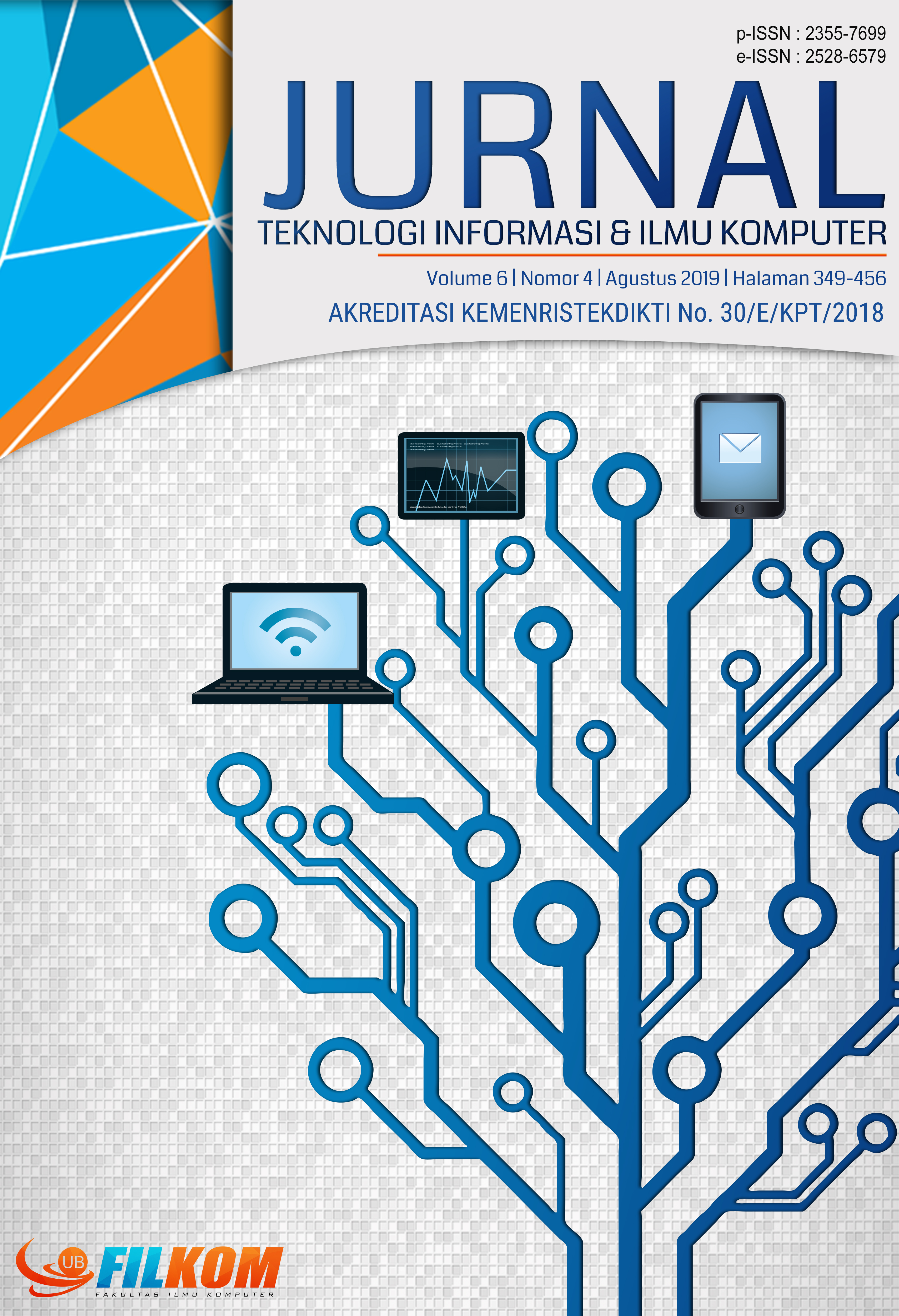Penerapan Pendekatan Human Centered Design dan CRM dalam Perancangan Antarmuka Sistem E-Complaint
DOI:
https://doi.org/10.25126/jtiik.2019641332Abstrak
Tujuan dari penelitian ini adalah untuk mengembangkan antarmuka sistem e-complaint dengan menerapkan HCD dan CRM. Komplain merupakan bentuk reaksi pelanggan terhadap produk atau jasa yang harus segera ditangani perusahaan. Dengan kondisi pencatatan komplain yang masih manual, menghambat upaya perusahaan untuk mencapai goal mempertahankan pelanggan. Oleh karena itu antarmuka sistem e-complaint hadir sebagai desain solusi yang dikembangkan dengan menerapkan HCD yang unggul dalam hal pendefinisian kebutuhan dari sisi pengguna dan stakeholder. Melalui HCD dapat diketahui bagaimana desain yang familiar bagi pengguna, dalam hal ini website dashboard. Dengan menerapkan CRM, pengembangan antarmuka sistem e-complaint dapat mengakomodasi kebutuhan perusahaan yang ingin proses bisnis dan kebutuhan fungsionalnya tetap menjadi pertimbangan utama. Penelitian ini menghasilkan 16 kebutuhan fungsional dan menyediakan hak akses untuk dua aktor yaitu sales dan leader. Hasil pengujian menunjukkan bahwa secara keseluruhan, antarmuka dan interaksi yang disediakan telah memenuhi kebutuhan stakeholder untuk mencapai goal. Namun, perlu menambahkan tampilan untuk segmentasi pelanggan untuk pengembangan desain berikutnya.
Abstract
The purpose of this research is to develop an e-complaint system interface by implementing HCD and CRM. A complaint is a customer reaction to a product or service that the company must address immediately. In the as-is condition of recording complaints are still manual, inhibits the company's efforts to achieve the goal of retaining customers. Therefore the interface of the e-complaint system comes as a design solution developed by applying HCD which is good for defining needs from the users and stakeholders. Through HCD can be known how the design is familiar to users, in this case the dashboard style. By implementing CRM, the development of the e-complaint system interface can accommodate the needs of companies that want their business processes and functional needs to be the main consideration. This study finds 16 functional requirements and provides access rights for two actors, namely sales and leader. The test results show that overall, the interfaces and interactions provided have met the needs of stakeholders to achieve the goal. However, it is necessary to add a view for customer segmentation for future design development.
Downloads
Referensi
BUTTLE, F. DAN MAKLAN, S., 2015. Customer Relationship Management, Concept and Technologies, Third Edition.
CHEN, I.J. DAN POPOVICH, K., 2003. Understanding customer relationship management (CRM): People, process and technology. Business Process Management Journal, 9(5), hal.672–688.
FLOH, A., ZAUNER, A., KOHLER, M. DAN RUSCH, T., 2014. Customer segmentation using unobserved heterogeneity in the perceived- value - loyalty-intentions link. Journal of Business Research, [daring] 67(5), hal.974–982. Tersedia pada: <http://epub.wu.ac.at/2792/>.
FRIEDRICH, I., SPRENGER, J., BREITNER, M.H. DAN SPRENGER, J., 2011. Discussion and Validation of a CRM System Selection Approach with Experts. In: Proceedings of the Seventeenth Americas Conference on Information Systems. Detroit.
GHONIYAH, N., 2012. Perilaku Komplain Dan Pengaruhnya Terhadap Kepuasan Dan Loyalitas Pelanggan Jasa. Dharma Ekonomi STIE Dharmaputra Semarang, (35), hal.12.
INDRIYANI, S. DAN MARDIANA, S., 2016. Pengaruh Penanganan Keluhan (Complaint Handling) Terhadap Kepercayaan dan Komitmen Mahasiswa Pada Perguruan Tinggi Swasta Di Bandar Lampung. Bisnis Darmajaya, 2(01), hal.13.
ISO9241-210, 2010. Human-centred design for interactive systems. International Organization for Standardization. Switzerland.
JAYAM, R. DAN RADHA, J., 2013. Factors Associated with Success and Failures in CRM. International Journal of Advance Research in Computer Science and Management Studies, 1(6), hal.163–168.
JESPERSEN, S., 2017. Dashboard Design Guidelines for Improved Evidence Based Decision Making in Public Health in Developing Countries. [daring] University of Oslo. Tersedia pada: <https://www.duo.uio.no/handle/10852/56916>.
KAHREH, M.S., TIVE, M., BABANIA, A. DAN HESAN, M., 2014. Analyzing the Applications of Customer Lifetime Value (CLV) based on Benefit Segmentation for the Banking Sector. Procedia - Social and Behavioral Sciences, [daring] 109(October 2015), hal.590–594. Tersedia pada: <http://linkinghub.elsevier.com/retrieve/pii/S1877042813051434>.
MAGUIRE, M., 2001. Methods to support human-centred design. International Journal Human Computer Studies, 55, hal.587–634.
MCKAY, E.N., 2013. UI is Communication: How to design intuitive, user-centered interfaces by focusing on effective communication.
PAL DHAKA, V. DAN NAHAR SCHOLAR, P., 2014. A Review : Benefits and Critical Factors of Customer Relationship Management. International Journal Advanced Networking and Applications, 2194, hal.2191–2194.
SANTOSO, A. DAN PUTRI, R.E., 2017. Pengaruh Faktor Internal dan Eksternal terhadap Tingkat Komplain Pengguna Kartu Kredit di Daerah Istimewa Yogyakarta. Jurnal Perilaku dan Strategi Bisnis, 5(49), hal.1–20.
TABLEAU, 2011. 5 Best Practices for Creating Effective Dashboards. Tableu Software, (August).
Unduhan
Diterbitkan
Terbitan
Bagian
Lisensi

Artikel ini berlisensi Creative Common Attribution-ShareAlike 4.0 International (CC BY-SA 4.0)
Penulis yang menerbitkan di jurnal ini menyetujui ketentuan berikut:
- Penulis menyimpan hak cipta dan memberikan jurnal hak penerbitan pertama naskah secara simultan dengan lisensi di bawah Creative Common Attribution-ShareAlike 4.0 International (CC BY-SA 4.0) yang mengizinkan orang lain untuk berbagi pekerjaan dengan sebuah pernyataan kepenulisan pekerjaan dan penerbitan awal di jurnal ini.
- Penulis bisa memasukkan ke dalam penyusunan kontraktual tambahan terpisah untuk distribusi non ekslusif versi kaya terbitan jurnal (contoh: mempostingnya ke repositori institusional atau menerbitkannya dalam sebuah buku), dengan pengakuan penerbitan awalnya di jurnal ini.
- Penulis diizinkan dan didorong untuk mem-posting karya mereka online (contoh: di repositori institusional atau di website mereka) sebelum dan selama proses penyerahan, karena dapat mengarahkan ke pertukaran produktif, seperti halnya sitiran yang lebih awal dan lebih hebat dari karya yang diterbitkan. (Lihat Efek Akses Terbuka).















